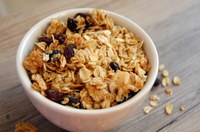Prairie Fare: What’s Your Knowledge of Food Labeling Lingo?
(Click an image below to view a high-resolution image that can be downloaded)
By Julie Garden-Robinson, Food and Nutrition Specialist
NDSU Extension
As I strolled through the grocery store the other day, I noticed people pausing and looking at the packages as they made their selections.
Maybe they were comparing prices and nutritional value. Maybe they were trying to find the products with the most distant “best if used by” or “sell by” dates.
We have a lot of information at our fingertips when shopping.
We have even more information online, and sometimes the variety of information can be confusing.
For example, “gluten free” is commonly misunderstood. Sometimes the term is on products that did not have the grain-based protein in the first place.
Gluten is a protein naturally found in wheat, barley and rye. Gluten is formed during the kneading process in breadmaking. Gluten acts somewhat like elastic and provides a framework for bread.
It sometimes is added to other products for various reasons, so those who have celiac disease need to be especially cautious about label reading.
Gluten is not harmful to the average person, so gluten-free diets are not recommended for the general public. However, those with celiac disease or gluten intolerance may experience harmful or unpleasant effects from gluten consumption.
Besides gluten, many other terms are used in conjunction with food on advertisements or labels not necessarily directly on the food package.
Can you identify the terms that correspond to these definitions? The answers are at the end.
- These two nutrients are required on the Nutrition Facts labels on most food products as of January 2020. One is a vitamin and one is a mineral. What are they?
- This term indicates the food was produced without synthetic pesticides, although some pesticides from natural sources can be used. Foods with this term are regulated by strict standards overseen by the U.S. Department of Agriculture (USDA).
- This notation on some foods indicates the crops were developed through genetic engineering. What is the term?
- For the term described in question No. 3, list at least four crops available today using the technique described.
- Meat, eggs and poultry that carry this labeling term have no artificial ingredients, including colorants or preservatives, and minimal processing. What is the term?
- Meats labeled with this term indicate the animals have eaten grass or hay 100% of the time. How might the meat be labeled?
Here are the answers.
- Vitamin D and potassium are the latest nutrients required on most Nutrition Facts labels. Vitamin D helps the body absorb calcium to keep bones strong. Milk is fortified with vitamin D for this reason. Adequate vitamin D also helps maintain a strong immune system, and plays a role in muscle movement and nerve transmission. Potassium is an electrolyte that helps our nerves function and our muscles contract. It helps maintain a healthy blood pressure.
- “Organic” is the term that indicates strict production guidelines were followed related to application of chemicals.
- “GMO” stands for “genetically modified organisms.” This plant breeding technique allows breeders to transfer a desirable trait from one organism to another. The desirable traits might include disease resistance or enhanced nutritional content.
- Several genetically modified food crops are available today, including sweet and field corn, soybeans, canola, sugarbeets, papaya, squash, cotton, Arctic apples and Innate potatoes. The apples and potatoes are less likely to brown.
- “Natural” is the term commonly used if the product has had minimal processing and typically has no added dyes or chemical preservatives added.
- “Grass fed” indicates the cattle were fed hay or grass 100% of the time after being weaned.
To dig more deeply into these labeling terms, explore more food labeling information from the Food and Drug Administration, the USDA or other reputable sources.
Looking for a snack that is high in fiber and features several Midwestern crops? Try this tasty snack or breakfast cereal.
Slow Cooker Honey Granola
4 c. old-fashioned oats, uncooked
6 Tbsp. honey
1/2 c. flax
1 c. bran cereal
1 c. raisins or dried cranberries
1/4 c. canola oil
Place all the ingredients in a 6-quart slow cooker and mix well. Put the cover on a little bit askew and cook on low for about three hours, stirring occasionally. Let cool on parchment paper and store in an airtight container for one to two weeks.
Makes 24 servings. Each (1/4 cup) serving has 130 calories, 4 grams (g) fat, 3 g protein, 23 g carbohydrate, 2 g fiber and 10 milligrams sodium.
(Julie Garden-Robinson, Ph.D., R.D., L.R.D., is a North Dakota State University Extension food and nutrition specialist and professor in the Department of Health, Nutrition and Exercise Sciences. Follow her on Twitter @jgardenrobinson)
NDSU Agriculture Communication - Sept. 2, 2021
Source: Julie Garden-Robinson, 701-231-7187, julie.garden-robinson@ndsu.edu
Editor: Ellen Crawford, 701-231-5391, ellen.crawford@ndsu.edu




